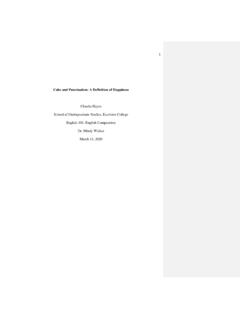Transcription of Cheap Thrills: The Price of Fast Fashion
1 1. Cheap Thrills: The Price of fast Fashion Suzanne Roberts School of Undergraduate Studies, Excelsior College English 101: English Composition Dr. Elizabeth Smith March 10, 2020. 2. Cheap Thrills: The Price of fast Fashion The cost of clothing is a concern for most American families. In an article for Newsweek's parenting column, Springen (2008) offered this advice to parents tackling back-to- school shopping: Steer your kids towards affordable stores like Old Navy and H&M, but don't force them to buy knockoffs. These days, even preschoolers can spot a pair of fake Ugg boots.
2 And may taunt classmates about them (para. 1). This advice appears sound and Commented [A1]: The author uses source material in her introduction to establish some context about the topic for her audience. sincere. However, such common wisdom hides the uncomfortable reality that most westerners are more concerned with getting a bargain than with the darker side of mass-consumer Fashion . Attachment to Cheap , disposable clothing, commonly known as fast Fashion , is supporting a corrupt labor system, unsustainable production practices, and a culture of mindless consumerism.
3 While the issue is complex, western consumers can contribute to a culture of change by revisiting some of their preconceived notions about frugality. Commented [A2]: The author here presents a strong thesis statement. This thesis is actually a two-sentence thesis, which works well and makes a clear assertion. Thesis With frequent stories in the news about factory accidents, the average consumer is at least statements should be one to two sentences long, should present the topic, and should make a clear assertion about the somewhat aware of the conditions most clothes are made under.
4 According to Dishman (2013) of topic. Forbes, Fashionistas often have a love/hate relationship with [mass-market] retailers like H&M. because they equate the inexpensive Price tag to the company's ability to manufacture its merchandise in sweatshops filled with underpaid workers (para. 8). Yet, this ambivalence does not translate into action because shoppers are used to getting what they want fast and Cheap . In his essay The Branding of Ethical Fashion and the Consumer, author and industry expert Nathaniel Beard (2008) described the polarization between the growing sense of moral obligation in Fashion and the consumer who is increasingly used to, and comfortable with, the availability of trend-led fashionable clothing that is extremely Cheap , and where there is actually relatively little guilt felt about its disposability (p.)
5 450). The instant gratification of an Commented [A3]: As the author introduces this important source for the first time, she addresses the ethos or credibility of the source. 3. inexpensive garment, such as a pair of sale pants from the Gap for three dollars, wins over humanitarian responsibility because it is convenient, fun, and more easily reconciled with the individual's bottom line. Plus, everybody is doing it. A middle-class mother or college freshman might reasonably argue they cannot afford to spend more because of financial restrictions.
6 Yet, a westerner's definition of deprivation often looks pretty rosy in comparison to the average living and working conditions in the underdeveloped world. Perhaps, buying fewer items is a better financial solution than repeatedly buying Cheap thrills. Similarly, consumers are willing to turn a blind eye to the health and environmental implications of their shopping habits in favor of steep discounts. According to Gershon (2005), Commented [A4]: Here, the author uses a strong topic sentence for a paragraph that focuses on how shoppers ignore the problems with the clothes they buy.
7 A third of a pound of pesticides, which contain known and suspected carcinogens, are used to make a simple cotton t-shirt (p. 56). He also noted that large amounts of chemical pesticides and fertilizers are used on both cotton and wool, which is harmful to life, both human and animal, and contributes to pollution (p. 56). Once again, this information is available to shoppers but often avoided because it contradicts the accepted mentality of consumption. Beard (2008). acknowledged Fashion companies do try to mislead consumers with their use of catch phrases such as ethical and fair trade (p.)
8 450), but he also emphasized that these same individuals rarely ask hard questions about their clothing (p. 448). Accepting a company's marketing as truthful and focusing instead on individual savings is simply easier than purchasing less or doing research. The gratification of a Cheap thrill is immediate, whereas the detriment to a wearer's health and the environment they live in may not noticeably surface for many years. Commented [A5]: According to APA 7th edition, the singular they can now be used. Health complications and chemical hazards during production and consumption are not Commented [A6]: This is an appeal to pathos.
9 The author is making a point that she hopes will trigger an emotional response in her audience. the only environmental risks associated with fast Fashion . The negative consequences of this cultural habit continue when a consumer disposes of a one-season garment in a charity shop or 4. landfill. According to H&M global head of sustainability Helena Helmersson, People in some countries cannot even afford H&M's brand of Cheap chic and that just reinforces the company's huge responsibility' to ditch the throwaway attitude in favor of sustainability (as cited in Dishman, 2013, para.)
10 9). Helmersson described the attitude of the masses in terms of having room for improvement, but the truth remains that her company, and the hundreds of others like it, propagate this phenomenon with their Cheap fabrics, construction, and manufacturing. The people who frequently purchase this type of garment will wear it for a small number of seasons before discarding it in favor of a new, but similar, garment. Thus, the cycle of more-is-more consumerism is upheld. Brands like H&M often maintain they can produce eco- Fashion on the Cheap , but this is the type of misleading marketing to which Beard (2008) referred in his article.



